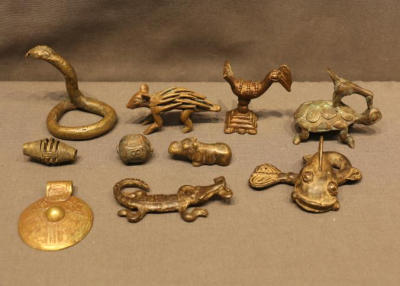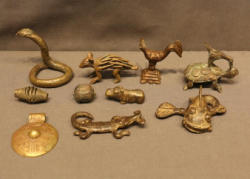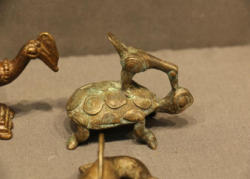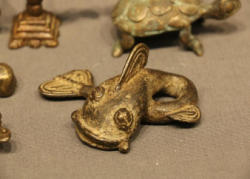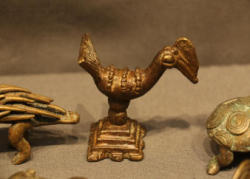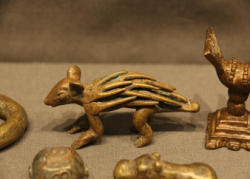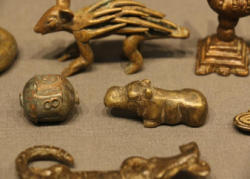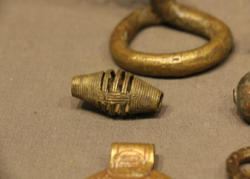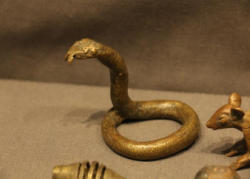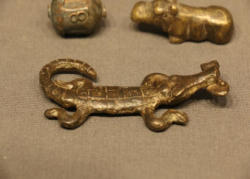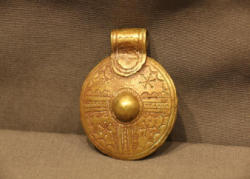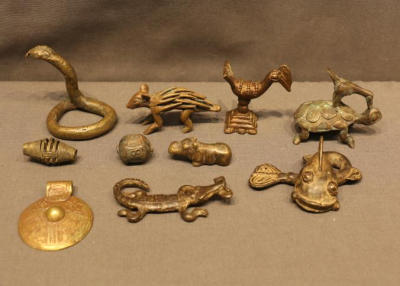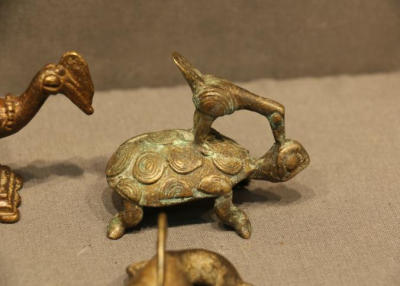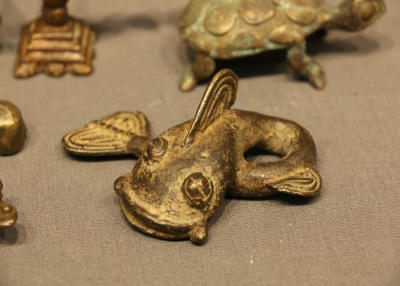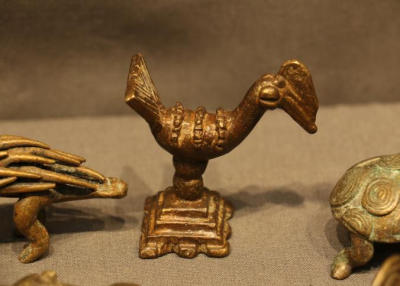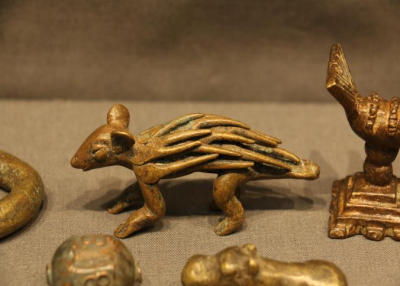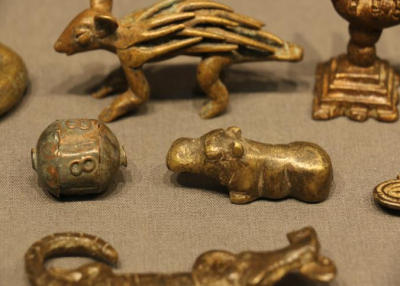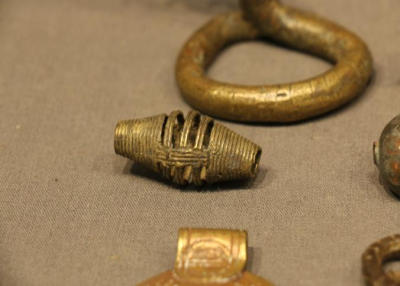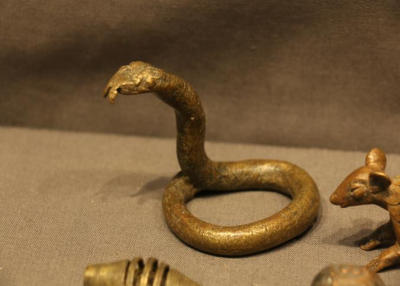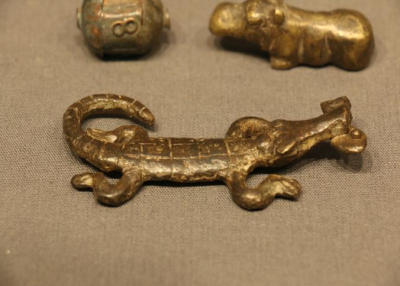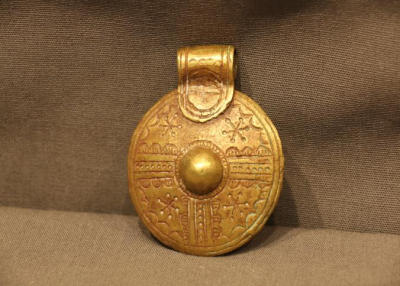Items located in Pleasant Valley, NY. Items include Faro, the water genie puppet from Mali; West African double gongs; Ode-lay society head crest mask from Sierra Leone; African sculptures, figurines, masks, textiles, ceremonial robes, copper rod currency, and more.
AFRICAN ART COLLECTION OF MARY SUE AND PAUL PETER ROSEN
Mary Sue and Paul Peter Rosen have collected African art for over thirty years, making nine trips to Africa to study the art in its cultural setting. The Rosens have published three African art books, curated more than ten exhibitions from their collection, and have given public lectures about African art and culture. They have donated art from their collection to various institutions including the Newark Museum, Temple University in Philadelphia, the SMA Fathers African Art Museum in Tenafly, New Jersey, and the African American Research Library in Fort Lauderdale, Florida.
Payment is due by Monday, April 1 at 1PM.
Pickup in Pleasant Valley, NY must be completed by Monday, April 1 at 3PM.
All lots sold as is, where is. There is a 15% Buyers Premium for all lots purchased. Payment methods include cash, MC, Visa, Discover or good check. You can make credit card payment online by going to your Member Area and selecting your invoice.
*NOTE* Shipping is available on all items.
AFRICAN ART COLLECTION OF MARY SUE AND PAUL PETER ROSEN
Mary Sue and Paul Peter Rosen have collected African art for over thirty years, making nine trips to Africa to study the art in its cultural setting. The Rosens have published three African art books, curated more than ten exhibitions from their collection, and have given public lectures about African art and culture. They have donated art from their collection to various institutions including the Newark Museum, Temple University in Philadelphia, the SMA Fathers African Art Museum in Tenafly, New Jersey, and the African American Research Library in Fort Lauderdale, Florida.
Payment is due by Monday, April 1 at 1PM.
Pickup in Pleasant Valley, NY must be completed by Monday, April 1 at 3PM.
All lots sold as is, where is. There is a 15% Buyers Premium for all lots purchased. Payment methods include cash, MC, Visa, Discover or good check. You can make credit card payment online by going to your Member Area and selecting your invoice.
*NOTE* Shipping is available on all items.
?EMBLEMS OF POWER. ASAFO FLAGS FROM GHANA? BY M.S. AND P.P. ROSEN IS ONLY AVAILABLE FROM THE AUTHORS AT ppr2001@med.cornell.edu PRICE POSTPAID IN US IS $25.00; OUTSIDE US POSTPAID $35.00.
Auction Info
Items located in Pleasant Valley, NY. Items include Faro, the water genie puppet from Mali; West African double gongs; Ode-lay society head crest mask from Sierra Leone; African sculptures, figurines, masks, textiles, ceremonial robes, copper rod currency, and more.
AFRICAN ART COLLECTION OF MARY SUE AND PAUL PETER ROSEN
Mary Sue and Paul Peter Rosen have collected African art for over thirty years, making nine trips to Africa to study the art in its cultural setting. The Rosens have published three African art books, curated more than ten exhibitions from their collection, and have given public lectures about African art and culture. They have donated art from their collection to various institutions including the Newark Museum, Temple University in Philadelphia, the SMA Fathers African Art Museum in Tenafly, New Jersey, and the African American Research Library in Fort Lauderdale, Florida.
Payment is due by Monday, April 1 at 1PM.
Pickup in Pleasant Valley, NY must be completed by Monday, April 1 at 3PM.
All lots sold as is, where is. There is a 15% Buyers Premium for all lots purchased. Payment methods include cash, MC, Visa, Discover or good check. You can make credit card payment online by going to your Member Area and selecting your invoice.
*NOTE* Shipping is available on all items.
AFRICAN ART COLLECTION OF MARY SUE AND PAUL PETER ROSEN
Mary Sue and Paul Peter Rosen have collected African art for over thirty years, making nine trips to Africa to study the art in its cultural setting. The Rosens have published three African art books, curated more than ten exhibitions from their collection, and have given public lectures about African art and culture. They have donated art from their collection to various institutions including the Newark Museum, Temple University in Philadelphia, the SMA Fathers African Art Museum in Tenafly, New Jersey, and the African American Research Library in Fort Lauderdale, Florida.
Payment is due by Monday, April 1 at 1PM.
Pickup in Pleasant Valley, NY must be completed by Monday, April 1 at 3PM.
All lots sold as is, where is. There is a 15% Buyers Premium for all lots purchased. Payment methods include cash, MC, Visa, Discover or good check. You can make credit card payment online by going to your Member Area and selecting your invoice.
*NOTE* Shipping is available on all items.
?EMBLEMS OF POWER. ASAFO FLAGS FROM GHANA? BY M.S. AND P.P. ROSEN IS ONLY AVAILABLE FROM THE AUTHORS AT ppr2001@med.cornell.edu PRICE POSTPAID IN US IS $25.00; OUTSIDE US POSTPAID $35.00.
Categories:
EARLY 20TH CENTURY GOLD WEIGHTS. Ghana, formerly the Gold Coast, and the surrounding region is naturally rich in gold which is found mainly in the form of small particles or dust. Gold was an important form of currency in the region for many centuries and by the 18th century it was used in virtually all transactions from buying yams in a market to affairs of state. Every person engaged in any form of commercial activity (buying and selling) needed to have equipment for measuring and weighing gold “dust”, including a set of weights. Although many brass weights were cast by the lost wax method specifically for this purpose, commonly available brass objects like beads and pendants were also used as weights. (A) Coiled fanged cobra. (B) Bird riding on a land turtle (certain birds do this to pick insects off the turtle). (C) Mammary-form shield pendant. (D) Two old brass beads. (E) Hippo. (F) Hornbill bird on pedestal. (G) Mudfish with coiled tail. (H) Porcupine. (I) Crocodile with fish in its mouth.
More Details
EARLY 20TH CENTURY GOLD WEIGHTS. Ghana, formerly the Gold Coast, and the surrounding region is naturally rich in gold which is found mainly in the form of small particles or dust. Gold was an important form of currency in the region for many centuries and by the 18th century it was used in virtually all transactions from buying yams in a market to affairs of state. Every person engaged in any form of commercial activity (buying and selling) needed to have equipment for measuring and weighing gold “dust”, including a set of weights. Although many brass weights were cast by the lost wax method specifically for this purpose, commonly available brass objects like beads and pendants were also used as weights. (A) Coiled fanged cobra. (B) Bird riding on a land turtle (certain birds do this to pick insects off the turtle). (C) Mammary-form shield pendant. (D) Two old brass beads. (E) Hippo. (F) Hornbill bird on pedestal. (G) Mudfish with coiled tail. (H) Porcupine. (I) Crocodile with fish in its mouth.
High Bid:
$120.00 – fallenlight
Auction Type: One Lot
Quantity: 1
Bidding has closed on this lot

